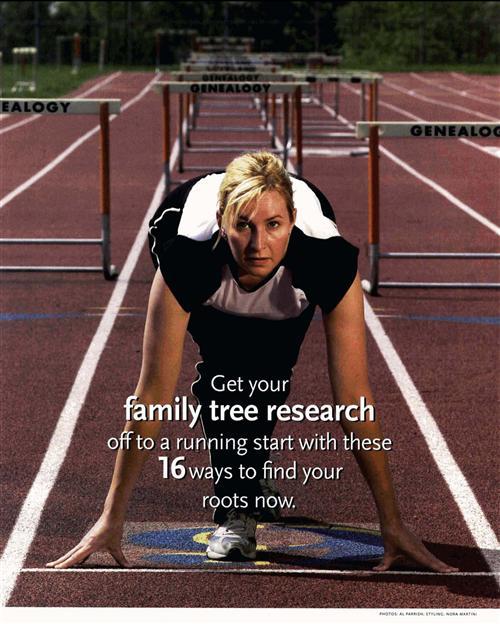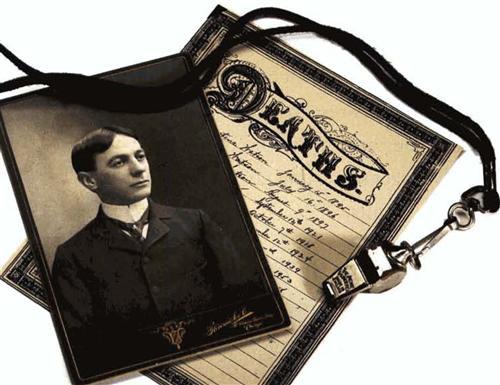
Remember that feeling of anticipation you got as a kid when you raced your friends in the neighborhood or schoolyard? You’d stand anxiously at the starting line, heart thumping, awaiting the signal to start — then in a flash, you’d be sprinting toward the finish line.
Starting the search for your roots feels a bit like that interminable instant between “ready … Set … “and “go!” You’re eager to experience the exhilaration of new family history discoveries. But you face an unfamiliar course, and without guidance, you’re afraid you’ll be running in circles. You’re not even sure in which direction to head.
Never fear: We’ve prepared a roots-research regimen guaranteed to put you on the path to finding your ancestors — no matter how new you are to genealogy. So get ready … get set… and go use these 16 ideas to get your research on the track to results.
1. Fill in a pedigree chart and family group sheets.
The best way to start tackling any research question is to figure out what you already know. So before you hightail it to the library or dig into online databases, fill in a five-generation ancestor chart (also called a pedigree chart) with as much of your family tree as you can.
Once you’ve written down names (don’t forget to use women’s maiden names) and vital stats for as many generations as you know, use a family group sheet to record details about each couple and their children. This form helps you keep track of siblings, aunts, uncles and cousins — “collateral relatives” who don’t go on your pedigree chart because they’re not in your direct lines.
2. Create a list of surnames.
Now that you’ve got those initial facts down, pull out a blank sheet of paper (or fire up your word processor) and create an alphabetical roster of all your relatives’ last names. This will serve as a quick index to the families you’re studying — after all, it gets tough to keep all those surnames straight once you’ve identified several generations. You also might want to color code your list; for example, highlight all the surnames from your mom’s side in yellow, and dad’s in green. Keep this list handy — you can refer to it when you check book indexes and query online databases.
3. Search the SSDI.
Don’t fret if your family tree’s branches look a bit thin: Many genealogists start out with information on only a few generations. For family lines that stall in the 20th century, check the Social Security Death Index (SSDI), which documents deaths reported to the Social Security Administration (SSA) since 1936 (most entries date from 1962 or later). The SSDI logs people’s birth dates, death dates and last residences — facts that can help you track down obituaries and vital records. With the SSDI info, you also can order a copy of your relative’s Social Security application from the SSA.
You’ll find free versions of the SSDI at:
• Family Search <www.familysearch.org> (click the Search tab, then US Social Security Death Index in the left frame)
• Family Tree Legends
<www.familytreelegends.com/ssdi>
• Genealogy.com <www.geneaiogy.com/ifftop.html> (it’s part of the Family Finder search engine)
• RootsWeb <ssdi.rootsweb.com> Each site supports different search parameters, so if you don’t get results with one version, try another. Or you can search three of the four sites from <www.stevemorse.org/ssdi/ssdi.html>. And remember: You won’t find relatives who didn’t receive Social Security numbers.
4. Interview a relative.
Now it’s time to put on your reporter’s hat and turn to the best sources for gathering basic family facts: your relatives. In particular, you’ll want to talk to your clan’s elders, who will have firsthand knowledge about ancestors you never had the chance to meet. Schedule a visit with Aunt Ethyl. You’ll likely come away with clues that’ll help you extend your pedigree, as well as stories and memories that will enrich your family history.
5. Raid Aunt Ethyl’s attic.
While you’re there, don’t forget to sift through family papers and heirlooms. Besides discovering new family history leads, you might stumble upon documents that aren’t in a library or archive — think family Bibles, old photos or your grandparents’ wartime love letters. “House hunting” also can save you time (and frustration) in locating genealogical records: Why hunt for Great-grandpa’s birth certificate if Aunt Ethyl already has it? Instead, you can spend that time searching for new facts and family connections.
6. Peruse old photo albums.
Speaking of photos, they’re great sources for genealogy — and not just because they show what your forebears looked like. You can use pictures to trigger Aunt Ethyl’s memories during your interview. And old photos may contain crucial family clues: For example, a photographer’s imprint might put your kin in a specific place at a specific time. You’ll find tips for developing photo-detective skills in our Photo Detective blog at <blog.familytreemagazine.com/photodetectiveblog>. You even can submit your mysterious pies for our photo expert, Maureen A. Taylor, to ID.
7. Get your parents’ and grandparents’ birth certificates.
Pull out your birth certificate and take a close look at the genealogical details it contains — then consider what you could learn from your parents’ and grandparents’ birth records. This is a great way to confirm the information you’ve gathered from memory and interviews with relatives. (After all, no one’s memory is foolproof — and in genealogy, sources matter as much as the facts themselves.) Plus, you may find enough new details — Aha! Great-grandpa’s age! — to jump-start your search for earlier generations.
If your progenitors are still living, ask them for copies of their birth certificates. Otherwise, you’ll usually have to turn to the counties where they were born. Most states place privacy restrictions on vital records: For example, documents may be sealed for a certain number of years, and you may need to prove you’re related to the person whose record you’re requesting. For state-by-state specifics, consult the National Center for Health Statistics’ Where to Write for Vital Records <www.cdc.gov/nchs/howto/w2w/w2welcom.htm>.
8. Look up your family in the census.
Some family history veterans would say you’re not truly a genealogist until you’ve tackled the census. Taken every 10 years since 1790, this federally administered head count is an ancestor hunter’s dream: The records brim with a bonanza of family details, including names, ages, relationships, residences, birthplaces and occupations.
9. Learn Soundex.
As you’ll realize, spelling doesn’t count in genealogy. You’ll have to search every possible variation of your ancestors’ names (and even some convoluted combinations you’d never expect).
Luckily, Soundex provides a shortcut. It’s an indexing system that assigns the same alphanumeric code to similar-sounding last names: Brown and Braun both are B560, for instance. Soundex was created for the federal census (you’ll find it for the 1880 and later enumerations); now it’s used in other indexes, too, especially Internet databases. You can learn more about how the system works in Emily Anne Croom’s Unpuzzling Your Past (Betterway Books).
Use the Soundex converter at <www.familytreemagazine.com/soundexgenerator> to find codes for your ancestral surnames. Here’s where that surname list you created will come in handy — just copy the names from your roster, then add the Soundex codes to your cheat sheet.
10. Connect with distant cousins.
Perhaps the best part about genealogy is that you’re not alone. Somewhere out there, your distant cousins are researching the same ancestors — and they’d love to connect with you and swap information.
Thanks to the Web, it’s easier than ever to find them. Just surf over to genealogy message boards such as the ones at Ancestry.comRoots Web <boards.ancestry.com>, Cousin-Connect <www.cousinconnect.com> and GenForum <genforum.genealogy.com>. These sites contain surname-, place- and subject-focused forums where you can post and search queries — basically, genealogical classified ads — in hopes of hooking up with fellow Pfeffer, Farmer or Friedman seekers. They log millions of visitors each month, so you have excellent odds of finding new family ties.
11. Seek the kindness of strangers.
Even folks who aren’t your kin are willing to help. You can tap into the network of genealogical do-gooders several ways. Start by joining e-mail lists that focus on your research interests. Within these electronic communities, you can get tips, ask questions and collaborate with others. Visit <lists.rootsweb.com> to find and sign up for mailing lists.
Can’t get to the Kalamazoo cemetery to see Grandma’s tombstone? Does your local library lack Virginia census microfilm? Request a lookup from the kind hearted volunteers at Books We Own <www.rootsweb.com/-bwo>, Genealogy Helplist <helplist.org> or Random Acts of Genealogical Kindness <www.raogk.org>. Just remember that one good deed deserves another. Don’t take help unless you’re willing to reciprocate.
Finally, contact your local genealogical society. It may have volunteers who can answer research questions, or offer classes where you can boost your research skills (see page 18).
12. Look for a book or article about your family.
People have pursued their pedigrees for centuries, which means a past genealogist might already have traced a branch of your clan. If he published his findings, you’ll have a huge head start.
13. Comb pedigree databases.
Genealogies aren’t published only in print: Family historians just like you have uploaded millions of pre-researched (albeit unverified) family trees to online “pedigree databases.” If you find an ancestor in one of these sites, you can download the entire file on that family — and perhaps add new branches to your family tree.
14. Get genealogy software.
Once you start collecting family information, you’ll meet your next-biggest genealogical challenge: staying organized. So get a genealogy software program to put your research in order. Family tree programs can perform many amazing feats with your family facts. A hidden benefit: As you enter data into the program, you might discover you’ve learned more than you thought (and conversely, you can easily identify the blanks you still need to fill in).
15. Go to the cemetery.
Graveyards are great places for genealogists to find dates — birth and death dates, that is. You can learn about your ancestors’ lives, too, from tombstone inscriptions. Even better, you might literally stumble upon other relatives: Since families often were buried together, the occupants of nearby plots also could be your kin.
16. Visit a Family History Center.
A segment of the world’s biggest genealogical collection may be housed in your own hometown, at an outpost of the Church of Jesus Christ of Latter-day Saints’ Salt Lake City-based Family History Library (FHL). Its 3,400-plus branch Family History Centers (FHCs) give you access to the FHL’s millions of microfilmed records and books from almost anywhere. You’ll also appreciate the assistance you can get from your local center’s staff. To find an FHC near you, go to <www.familysearch.org> and click the link under Family History Library System. Then hop in the car — or lace up your sneakers — and go! The race to trace your roots has begun.
From the September 2004 Trace Your Family History.





